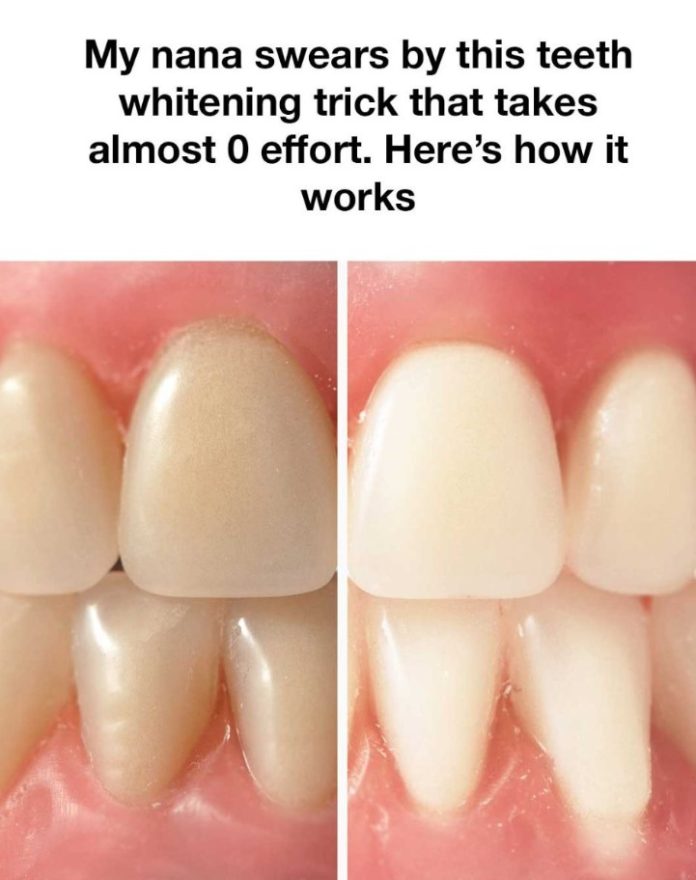My grandma’s infectious grin has always been her most distinctive feature. Her pearly whites are so perfect that even at 80 years old, she looks like someone who spent hundreds of dollars on cosmetic dentistry or an expensive at-home kit. But what if I told you that her secret to maintaining such a dazzling smile is a simple, time-honored remedy that requires minimal effort? Best of all, the key ingredient might already be sitting in your kitchen.
Let me unveil the secret to my grandma’s stunning smile, explain how it works, and offer some tips to maximize the benefits of this easy and natural method.
The Hidden Gem: Baking Soda
You might be surprised to learn that the secret behind my grandma’s radiant smile is none other than baking soda. Known primarily for its cleaning and deodorizing properties, baking soda is also an effective and natural teeth-whitening agent. This method, passed down through generations, predates the modern era of costly teeth-whitening solutions and offers a simple, economical alternative.
Why Baking Soda?
Baking soda, chemically known as sodium bicarbonate, is a mild abrasive that works wonders in removing surface stains caused by coffee, tea, red wine, and tobacco. Its gentle abrasiveness helps break down particles on the enamel’s surface without causing harm. Additionally, baking soda’s alkaline nature helps neutralize acidity in the mouth, protecting tooth enamel from acidic foods and beverages. Its antibacterial properties also contribute to improved oral health by reducing the number of harmful microorganisms in your mouth.
How to Use Baking Soda for Teeth Whitening
Here’s a step-by-step guide to incorporating baking soda into your oral hygiene routine, based on my grandma’s tried-and-true method:
1. Prepare the Paste:
Create a thick paste by mixing a small amount of baking soda with water. Combine approximately half a teaspoon of baking soda with just enough water to form a paste-like consistency. The paste should be thick enough to adhere to your toothbrush without dripping.
2. Apply and Brush:
Dab the paste onto your toothbrush and use gentle, circular motions to brush your teeth. Avoid brushing too vigorously, as excessive scrubbing can wear down tooth enamel over time. Ensure that you cover all surfaces of your teeth for even whitening.
3. Rinse Thoroughly:
After brushing, rinse your mouth thoroughly with water to remove any residual baking soda. This step helps prevent any leftover baking soda from causing irritation or discomfort.
4. Frequency and Moderation:
For optimal results, use the baking soda paste two to three times a week. Overuse can lead to enamel erosion, so it’s important to avoid applying it daily. Moderation is key to achieving a brighter smile without compromising tooth health.
Why Baking Soda Works
Baking soda is a gentle yet effective alternative to commercial teeth-whitening products, which often contain harsh chemicals like carbamide peroxide or hydrogen peroxide. Unlike these treatments, baking soda is all-natural and provides a milder whitening effect. It removes surface stains without causing irritation or sensitivity, making it a suitable choice for those with sensitive teeth or gums.
Benefits of Baking Soda Whitening:
- Cost-Effective: Baking soda is an affordable and accessible option for those looking to brighten their smile without breaking the bank.
- Effortless: The method requires no special preparation or equipment, making it a convenient addition to your regular oral care routine.
- Gentle on Teeth: Free from harsh chemicals, baking soda reduces the risk of tooth sensitivity and gum inflammation.
- Additional Health Benefits: Besides whitening, baking soda’s antimicrobial and acid-neutralizing properties contribute to overall oral health.
Tips for Best Results
To maximize the benefits of this simple teeth-whitening method, consider the following tips:
1. Maintain Daily Oral Hygiene:
Continue to floss regularly and use fluoride toothpaste twice a day. Baking soda should complement, not replace, your standard oral care routine.
2. Avoid Staining Agents:
Minimize consumption of foods and beverages that can stain your teeth, such as sugary drinks, coffee, tea, and red wine, to prolong the effects of whitening.
3. Stay Hydrated:
Drinking plenty of water helps keep your mouth clean and reduces the likelihood of new stains forming by washing away food particles and bacteria.
4. Use a Soft-Bristled Toothbrush:
Opt for a toothbrush with soft bristles to prevent excessive abrasion of the enamel, as baking soda is mildly abrasive.
5. Be Patient:
Baking soda may take longer to show results compared to some commercial products. However, with consistent use, you’ll soon notice a brighter, more radiant smile.
Conclusion :
My grandma’s baking soda technique is a testament to the effectiveness of simple, natural remedies. By incorporating this time-tested method into your oral care routine, you can achieve a brighter smile without relying on costly treatments or harsh chemicals. Baking soda offers a gentle, cost-effective way to combat surface stains while promoting overall oral health. So why not give this classic remedy a try and experience the benefits of a naturally radiant smile, just like my grandma?
Source of the picture : Barbara O’Neill Lectures










